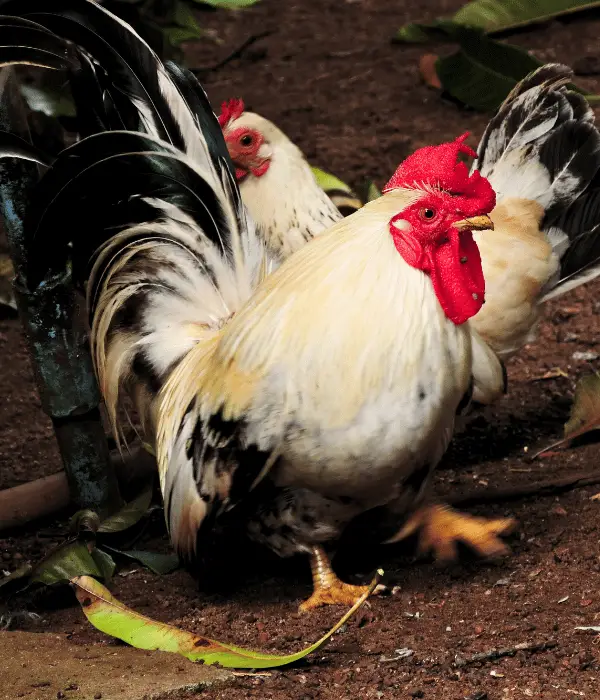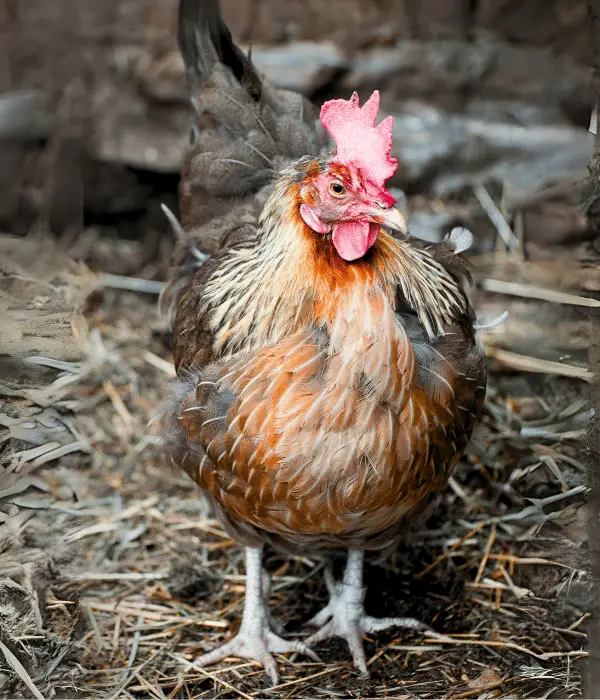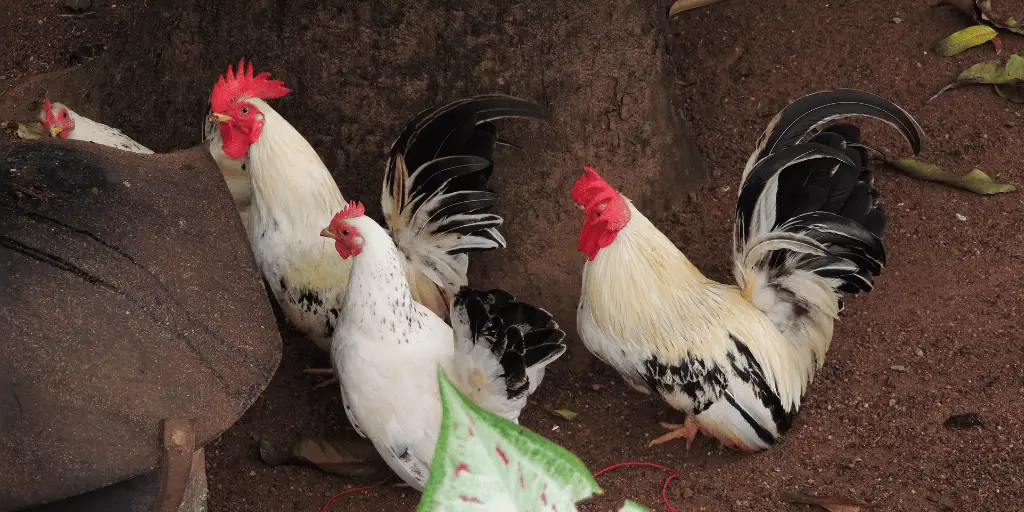If you want to know about Dorking chicken, this breed guide will significantly help you.
It is an excellent ancient chicken that serves as a fantastic table bird and an egg-laying bird. So, we can say they are an excellent dual-purpose chicken breed.
Information such as history and origin, size, color, appearance, benefits, and problems associated with raising Dorking chickens are included in this guide.
Before you decide to purchase this chicken breed, please go through this informative article to see whether this breed will be suitable for your backyard or not.
What is Dorking Chicken?
Dorking is an old British domestic chicken breed. It is named Dorking for the town of Surrey in South East England.
This ancient British breed of chicken was mainly used as a table bird in its history. Dorking chickens are known for their extra hind toe and relatively short legs.
It is believed that the Romans first introduced Dorking chicken in AD 47 in England. This chicken is considered a good winter layer.
The hens of this breed are excellent mothers and are broody. Dorking has red earlobes, which are uncommon in layers of white eggs.
You can see this chicken in white, red, cuckoo-colored, and silver-gray. They were introduced to the United States poultry show community in 1849. Gradually, they were replaced by commercial hybrid meats, and now they are a rare breed.
The APA recognized it in 1847, and it is listed on ‘The Livestock Conservancy threatened‘ list.
History and Origin
Dorking is the oldest among all British chicken breeds. It is believed to have originated from five-toed chickens brought to Britain by the Romans within the first century AD.
The Dorking was initially named for the market town in the home country, which is near South East England.
Unless Sussex replaced it in the early twentieth century, it is a meat breed supplied to the metropolis. This chicken was shown in an exhibition at the London Zoo in 1845.
Dorking was included in the Poultry Club of Great Britain in 1865 by William Bernhardt Tegtmeier. It was included as the first poultry standard.
In the late nineteenth century, various color breeds were formed. Dorking and Scottish Dorking are the two colored breeds.
None of these breeds existed when the Second World War was in its decline stage. The Dorking Club has formed again in 1970.
In 1874, the American Poultry Association added three colors, silver-grey, white, and gray, to its Primary Standard of Perfection. They added red in 1995, and three bantam varieties, silver, gray, and rosecomb, were added in 1960.
Egg Production
Dorking hens produce eggs throughout the winter, unlike other breeds. The eggs are white or creamy in color. Read our list of chickens that lay colored eggs.
The hens begin laying in the early part of the year and can lay for about two to three years until they mature.
They usually lay medium to large-size eggs with a lightly tinted color. A healthy Dorking hen lays around 140–150 eggs per year.
Temperament
Dorking chickens are calm, friendly, and tolerant. They are broody and good mothers because they raise their baby chicks well.
The hens of this breed are lovely mothers and take care of their chicks very well. They don’t kick their babies out of their nest.
Dorking hens can care for other hen’s babies if they leave them without brooding. That’s why they are in the last of the pecking order of a flock.
Like hens, Dorking roosters are also typically calm and docile. So, you will rarely see any aggressiveness from the roosters.
Here is our list of the best portable chicken coop ideas with DIY
Lifespan
On average, Dorking chickens live 6–8 years, but some can live longer with adequate care. The lifespans depend on genetics, nutrition, living conditions, and healthcare.
Their longevity can be extended by providing a balanced meal, clean water, a large and safe environment, and frequent veterinary checkups.
Dorking Chicken Recognized Varieties

Below are the APA-recognized Dorking chicken varieties:
Bantam Dorking Varieties: Rose Comb White, Single Comb Colored, Single Comb Silver Gray.
Large Fowl Dorking Varieties (English): Single Comb Colored, Rose Comb Cuckoo, Single Comb Cuckoo, Single Comb Red, Single Comb Silver Gray, Rose Comb White.
Size and Weight
The size of a Dorking Chicken is around 8lbs. It is a bulky meat chicken, weighing around 8 lbs, with standard-sized roosters and 3 lbs bantam roosters.
The standard size hens of this breed have around 6 lbs, and bantam hens have 2 lbs kg weight.
They have a long back with a broad chest. They appear small due to their short legs but are bulky, making them good meat chickens.
Appearance
Dorking chickens are noted for their unusual appearance and characteristics. Roosters and hens have rectangular bodies and lengthy backs.
Their silky, close-fitting feathers give them a sleek, beautiful appeal. Depending on the variety, Dorkings have white or yellow skin.
The beaks are yellow, and red earlobes and wattles are medium-sized and red. Dorkings have yellow legs and a medium-sized single comb, matching their appearance.
They have medium-sized yellow legs. Their straight, well-spaced toes provide stability and balance.
The Dorking chicken’s appealing appearance sets it apart from other breeds.
Dorking Rooster Vs Hen
Dorking roosters are often larger and heavier than their female counterparts. Their average weight is 9 lbs. They have brighter plumage, like many kinds of roosters.
Their combs and wattles are darker red and more prominent. Rooster tail feathers are more giant and curved. Roosters also crow loudly to demonstrate their dominance or start the day.
Dorking hens weigh approximately 7 lbs and are smaller and lighter than roosters. They blend in with their environment and protect their eggs due to their mellow plumage than roosters.
They have smaller wattles and combs than the rooster. The hens of this breed are recognized for laying eggs. As a good mother, they raise their chicks very well.
Benefits of Raising Dorking Chickens

- Ancient Breed: Roman or Phoenician traders may have brought Dorking chickens to reality. Their secret origin gives your backyard a historical feel and preserves a piece of heritage.
- Flavorful Meat: Dorkings are ideal for home meat production due to their soft, tasty meat. Raising Dorking hens for personal or market consumption provides delicious food.
- Great Egg Layers: Dorking hens produce many eggs, especially in winter. They consistently lay fresh eggs, providing a vital and tasty resource for your household.
- Broodiness: Dorkings are broody and like to sit on their eggs. This natural habit helps backyard breeders create a self-sustaining flock and exhibit the chicken’s maternal instincts.
- Polydactylism: Dorkings have five toes due to polydactylism. They’re different from other chicken breeds, providing interest and personality to your herd.
- Hardy and versatile: Dorkings survive in many conditions. They are adaptable to many climates, giving chicken keepers worldwide adaptability.
- Docile Temperament: Dorkings are calm and docile. Their calmness makes them ideal for families with children or inexperienced chicken keepers, making backyard hens more fun.
- Variable sizes: Dorking chickens are available in full-size and bantam sizes to meet different space needs and preferences. Dorking sizes suit large and small backyards.
- Color Variety: Dorkings give visual interest to your lawn with their color and comb variety. Different color patterns and comb types can add to the appearance and functionality of your poultry.
- Conservation: Raising Dorking hens helps preserve and raise the rare breed. Dorkings went out of favor with the rise of the commercial meat business, but backyard enthusiasts help preserve and improve this unique chicken breed.
Raising Dorking chickens contributes to conserving this heritage breed, which currently has a “watch” conservation status.
Common Problems in Raising Dorking Chickens
Here are a few common problems that you may see while raising Dorking chickens:
Housing and Space Needs
Dorking chicken owners may struggle to provide sufficient space and housing. Dorkings are larger breeds; therefore, each bird requires space to roam and move freely.
If you have many hens, check with your local or state government law on animal property allocation.
Hygiene/Dropping Management
Unmanaged chicken droppings can be a problem. This applies to all chicken breeds, including Dorkings. Maintaining hygiene and preventing odors requires regular coop cleaning and proper bedding.
Keep the straw bedding three to four inches deep and add diatomaceous earth for odor control. Weekly cleaning reduces odors, pests, and rodents.
Manage and Prevent Disease
Dorking chickens are disease-prone like all chickens. Responsible poultry owners must know illness patterns and prevention methods.
Cleaning the coop, adopting biosecurity, and monitoring chicken health are essential to disease prevention and management.
See a poultry vet for diagnosis and treatment if your flocks seem sick or act strangely.
Controlling Rooster Aggression
Dorking chickens are peaceful, although roosters may attack intruders or other chickens. A rooster in your flock must be monitored to ensure they do not harm other chickens or humans.
If necessary, separate roosters and constantly watch their interactions. An experienced chicken keeper or poultry professional can help manage and mitigate rooster violence.
Handling Broodiness
Dorking chickens often go broody, sitting on their eggs and hatching them. Broodiness can help naturalists reproduce, but it can reduce egg production.
Dorking hens may need to be less broody if you want more eggs. To prevent hen clutches, frequently retrieve eggs from nesting boxes.
Creating a pleasant and separate nesting place for broody chickens can also reduce flock egg-laying disturbances.
Dorking Chicken Care Tips and Solutions
Here are a few care tips to enhance your Dorkings life and health:
Plenty of Outdoor Space and Enrichment
Dorking chickens need plenty of outside areas for foraging and exercise to stay healthy. Dorkings are good free-rangers and like to explore.
Securely fence your yard or outdoor area to keep predators out while letting them wander and play.
Give your Dorkings dust baths, perches, and plants to peck and investigate, stimulating their minds and bodies.
Nutrition and Feeding Balance
Dorking chickens require a balanced diet to stay healthy and productive. To guarantee laying hens get enough nutrition, feed them high-quality commercial feed.
Add fresh produce and kitchen scraps to their diet for variety and nutrition. To avoid overfeeding or underfeeding, watch their feed consumption and modify portions. Chickens require clean, fresh water to stay healthy.
Correct Coop and Nesting Box Design
Dorking chickens need a comfortable and safe home and nesting box. Maintain a well-ventilated, insulated, and predator-proof coop.
The nesting boxes should be clean, pleasant, and accessible for chickens to lay eggs. To promote egg-laying, provide enough straw or wood shavings. Check and clean nesting boxes regularly to prevent pests and infections.
Regular Vet Visits and Health Checks
Dorking chickens require regular health monitoring to discover health risks early. Check their behavior, appetite, and looks daily. Look for lethargy, odd droppings, respiratory problems, or plumage changes.
Develop a relationship with a poultry veterinarian to help your flock stay healthy. See your vet for regular checkups and vaccines to prevent and treat diseases.
Dorking Cockerel (The Sculpture)
The “guerrilla knitters” group in Dorking came up with the idea to put the gold medal on the Dorking chicken sculpture.
The medal wasn’t really “given” to the chicken; it was just a sign of celebration for London 2012 Olympics. A well-known landmark in Dorking is the sculpture of a chicken.
The knitters wanted to include it in the party to bring attention to Dorking during the global event. People also saw the medal as a tribute to the town’s important past and link to the Dorking chicken breed.
Conclusion
Dorking chicken is the oldest chicken breed in all the other British chicken breeds.
It has a very calm, gentle personality and a good forager. It is a versatile dual-purpose bird that can be used for both meat and egg production.
This pleasant yardbird is friendly, lovable, and an excellent mom. These birds came from the Ancient Romans, but they are becoming rare today.
I hope this breed guide on Dorkings helped you learn more about them.


Can you help me find some colored dorkings that I can start raising here in the northwest. 509-961-9309
Thanks for asking here, you can ask your nearest chicks providers or try some websites like my pet chickens
Looking to buy white Dorking eggs to raise chicks.